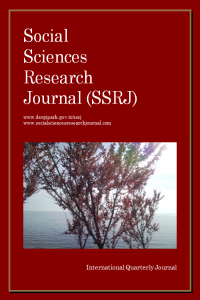Döviz Kuru İle Faiz Oranları Arasındaki Nedensellik İlişkisi: 2006-2018 Dönemi
Döviz Kuru, Faiz Oranı, Eşbütünleşme
Causal Relatıonshıp Between Exchange Rate And Interest Rates: 2006-2018
Exchange Rate, Interest Rate, Cointegration,
___
- ALACAHAN, N. D. (2011). Enflasyon, döviz kuru ilişkisi ve yansıma: Türkiye the relationship between ınflatıon, exchange rate and pass through: turkey. Sosyal Bilimler Dergisi, (1), 49-56.
- ALAM, S., BUTT, M. S., IQBAL, A.,& BHATTİ, R. H. (2001). The Long-run Relationship between Real Exchange Rate and Real Interest Rate in Asian Countries: An Application of Panel Cointegration [with Comments]. The Pakistan Development Review, 577-602.
- BAHMANİ-OSKOOEE, M., & NG, R. C. W. (2002). Long-run demand for money in Hong Kong: an application of the ARDL model. International journal of business and economics, 1(2), 147.
- BAUTİSTA C.C. (2003). “Interest Rate–Exchange Rate Dynamics in the Philippines: A DCC Analysis”, Appl. Econ. Lett. 10, 107–111.
- BERUMENT, H., & GÜNAY, A. (2003). Exchange rate risk and interest rate: a case study for Turkey. Open economies review, 14(1), 19-27.
- DASH, P. (2012). The Relationship between interest rate and exchange rate in India.
- Dickey, D. A. & W. A. Fuller. (1981). Likelihood Ratio Statistics for Autoregressive Time Series With a Unit Root. Econometrica, 49 (4), 1057-1072.
- DOĞAN, İ.; AFSAL M.Ş.; AYDIN, S. & GÜRBÜZ, S. (2017). “Faiz Oranları ve Döviz Kuru Dönemsel Analizi; Türkiye Örneği”, Vol:3, Issue:13; pp:199-205 (ISSN:2149-8598)
- ETHEM, E. S. E. N., YILDIRIM, S. & KOSTAKOĞLU, S. F. (2012), Feldstein-Horioka Hipotezinin Türkiye Ekonomisi İçin Sınanması: ARDL Modeli Uygulaması. Eskişehir Osmangazi Üniversitesi İktisadi ve İdari Bilimler Dergisi, 7(1).
- GOLDFAJN, I., & BAİG, T. (1998), Monetary policy in the aftermath of currency crises: the case of Asia.
- GRANGER, C. W. J. (1969), Investigating Causal Relations by Econometric Models and Cross-spectral Methods. Econometrica, 37(3), 424-438.
- GÜL, E. EKİNCİ, A., & ÖZER, M. (2007). Türkiye’de faiz oranları ve döviz kuru arasındaki nedensellik ilişkisi: 1984–2006. Iktisat Isletme ve Finans, 22(251), 21-31.
- GÜMÜŞ, İ. (2002) Effects of the Interest Rate Defense on Exchange Rates during the 1994 Crisis in Turkey. TCMB Working Paper, No: 14.
- GÜRİŞ, B.(2018) Doğrusal Zaman Serileri Analizi. (Yayımlanmamış Ders Notu)
- SAMANİ, H.A.& ANSARİ, M.S (2017) Investigating the relationship between interest rate and exchange rate: Application to a VAR model"
- HAKKİO, C. S. (1986). Interest rates and exchange rates–What is the relationship. Economic Review, (Nov), 33-43.
- KARACA, O. (2005). Türkiye'de Faiz Oranı ile Döviz Kuru Arasındaki Ilişki: Faizlerin Düşürülmesi Kurları Yükseltirmi? (No. 2005/14). Discussion Paper, Turkish Economic Association.
- KAYHAN, S., BAYAT, T., & UGUR, A. (2013). Interest Rates and Exchange Rate Relationship in BRIC-T Countries/BRIC-T Ülkelerinde Faiz Orani ve Döviz Kuru Iliskisi. Ege Akademik Bakis, 13(2), 227.
- OKUR, A. (2017). Türkiye Ekonomisinde Faiz Oranı ve Döviz Kurunun EnflasyonHedefi Üzerine Etkisi. Yalova Sosyal Bilimler Dergisi, 146.
- SARAÇ, T. B., & KARAGÖZ, K. (2016). Impact of Short-term Interest Rate on Exchange Rate: The Case of Turkey. Procedia Economics and Finance, 38, 195-202.
- SEVER, E., & MIZRAK, Z. (2007). Döviz Kuru, Enflasyon Ve Faiz Oranı Arasındaki İlişkiler: Türkiye Uygulaması. Sosyal Ekonomik Araştırmalar Dergisi, 1(13), 264-283.
- SEVÜKTEKİN, M. & M. ÇINAR. (2017). Ekonometrik Zaman Serileri Analizi. (5.Baskı).
- SHASTRİ, S. ve SHASTRİ, S. (2016). Exchange rate interest rate linkages in India: an empirical investigation. Journal of Financial Economic Policy, 8(4), 443-457.
- STOCK, J. H., & WATSON, M. W. (2012). Introduction to econometrics: Global edition. Boston, MA: Pearson Education.
- TARI, R. (2015). Ekonometri. (11.Baskı). Kocaeli: Umuttepe Yayınları.
- TCMB (2003) Merkez Bankası Faiz Oranlarının Düşürülmesine İlişkin Basın Duyurusu. Sayı: 2003-31.
- UYSAL, D., MUCUK, M., & ALPTEKİN, V. (2008). Finansal serbestleşme sürecinde Türkiye ekonomisinde faiz ve kur ilişkisi.
- YILDIRIM, K., KARAMAN, D. & TAŞDEMİR, M. (2008). Makroekonomi. Eskişehir: Seçkin Yayınevi.
- Yayın Aralığı: Yılda 4 Sayı
- Yayıncı: Denta Florya ADSM Limited Company
Yoksulluğun Giderilmesinde Sosyal Yardım Alan Yetişkinlerin Meslek Eğitimi
Dilek ALTAŞ, Selay Giray Yakut, Özlem YORULMAZ
Girişimcilerin Yatırım Kararı Süreçleri
H.tezcan UYSAL, M. Güçlü KAYHAN
Çok Düzeyli Çalışmalarda Propensity Skor Yönteminin Kullanımı
Elif Çiğdem ALTUNOK, Dilek ALTAŞ, Deniz KIRAÇ
“Dans veya Bale’nin, Figüratif Soyutlama Çalışan Heykeltıraşlarımızın Yapıtlarında Değerlendirilmesi
Gümüş Sörfçüler: Yaşlıların İnternet Hakkındaki görüşleri, deneyimleri ve düşünceleri
CUSTOMER CLUB MEMBERSHIP CARDS MANAGEMENT IN CONTEMPORARY FOOD RETAILERS
M.ömer AZABAĞAOĞLU, Yasemin ORAMAN
Üniversite Gençlerinin Duygu Yönetimi Becerileri Üzerine Bir Araştırma
